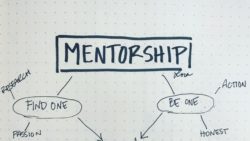Learning from mistakes in architecture
If you’ve read any of my other blogs, you know I’m a major proponent of continued learning, pushing past fear, and therefore learning from your mistakes. Let’s look today at what it might mean to be present in your career in a way that allows learning from mistakes in architecture to make the “mistake” the next “success”.
Note: This is the forty-third post in a group series called #ArchiTalks. This month’s topic is “Learning from mistakes.”
Learning from mistakes in architecture can be as varied as “how do I learn better from the people around me” to “how do I learn from a shop drawing that was unclear and am now having to revisit on site” to “how do I learn from the mistakes of burying myself in too much work and burning out” and everything in between. Let’s look at some of them.
Mistake: not using the human resources around you.
No, I’m not talking about the HR department. (Although, they have a lot of resources, too) If you’re working in a firm or are currently going through school, it’s important to realize how much knowledge you are surrounded with – NO MATTER WHAT STAGE OF YOUR CAREER you can always learn something new – and the easiest source is from the people around you that you interact with on a daily basis. You each bring different backgrounds, life experiences, and expertise to your work. Your project is likely different from theirs, or in the case of studio, is the same problem but approached differently to create the solution.
Check in. Don’t be afraid to ask a question. Go to coffee or for a drink and talk about what you’re each learning from the projects you’re working on. Keep each other accountable and up to date and you both learn in the process. Win-win.
Mistake: learning from mistakes in architecture submittals
(or the construction process)
Every person’s first experience of seeing a project through CA (Construction Administration) can be daunting. It’s a lot of responsibility with real dollars and time consequences and (the paperwork, at least) can look like a foreign language. It’s REALLY important to have a good mentor* for your first CA experience. I had a great one for my first experience and I still look to him as a mentor and guide in the process.
*A firm likely will not throw you into deep water on your own for your first experience because it’s important to them to create a profitable and safe project, but there are the rare occasions where that might be the case. If you find yourself here, reach out to another mentor to talk through your questions. There are many ways to navigate your learning process and they don’t all have to happen in the office.
No matter how great your mentor is, there will be learning lessons on each project. And some of them come up with the communication and interaction with the contractor and fabricators. It’s important to understand the difference between what’s in your model, what the intent is (which is hopefully clear in the construction drawings), what’s in the shop drawing/RFI, and/or what’s in the specification/project contract. Sometimes a detail changes and a referring tag gets missed and the contractor is unclear on how to detail a ceiling. Sometimes a fabricator will choose to approach the creation of a portion of your structure differently than you showed. If it’s important to you, you pick it up in the shops and have a conversation. If your contract and specifications say otherwise (perhaps it’s delegated design), you check for intent and code compliance and let them do their thing. Either way, you will likely have an instance of miscommunication or missed information in some form during the construction process of your project. Hopefully, it’s minimal and only bruises the ego a little. Hopefully, it doesn’t cost a ton of money. No matter what the scenario is, this learning moment will be engrained in your brain for a very long time. This is part of learning from mistakes in architecture. You (hopefully) aren’t recycling details from project to project, but you can bet your salary that you’ll acutely pay attention to the conditions on your next project in the area where there were issues on the last project.
Mistake: too much architecture, not enough you.
When you’re passionate about what you do, as most of us architects are, it’s easy to not consider the extra projects, the volunteering, and the creative hobbies as work. But the time spent for others adds up. Yes it’s beneficial, but you also have to practice self-care so that you CAN keep giving. So this one is easy (to say, not to do).
PROTECT YOUR TIME.
I’m still not great at this. I’m passionate about what I do. I love helping others. But I’ve also realized I have to help me so that I can keep doing that. That means more time with the pups and less late nights. It means being real with my schedule before I say yes to sitting on another board or volunteering for another weekend community project. I’ve learned to always double the time I’m told a volunteer position will take up in my schedule. Either because of travel, unforeseen events or longer meetings, that additional time adds up and can crunch an already packed schedule. It’s important to also schedule in your “you” time. I recently got my childhood piano moved to my house (now that the dining room is done – yay!) and one of the first things I did was schedule in time on my calendar to get back into a habit of practicing/playing. It’s 30min, 4 days a week that I can look forward to some peaceful me time and it’s so beneficial to me. What’s your “you” thing? Put it on your calendar. And protect it.
The point is, mistakes will happen. But if you can learn from your mistakes in your architecture career, you will be one step ahead when the next problem to solve comes along.
To see the take on “Words” from other Architects, follow the links to the others in the #ArchiTalks group who are posting today on the theme:
- Lee Calisti, AIA – Think Architect (@LeeCalisti) “some kind of mistake”
- James Mehaffey – Yeoman Architect (@jamesmehaffey) “Learning from Mistakes”
- Eric Faulkner – Rock Talk (@wishingrockhome) “Archi-scar – That Will Leave a Mark!”
- Michele Grace Hottel – Michele Grace Hottel, Architect (@mghottel) “Learning from Mistakes…”
- Jeffrey Pelletier – Board & Vellum (@boardandvellum) “Are Architects Experts?”
- Mark Stephens – Mark Stephens Architects (@architectmark) “Learning from mistakes”
- Brian Paletz – The Emerging Architect (@BPaletz) “Forgotten Mistakes”
- Keith Palma – Architect’s Trace (@cogitatedesign) “A, B, C, D, E…”
- Steve Mouzon – The Original Green Blog (@stevemouzon) “How Living Traditions Learn From Mistakes”




